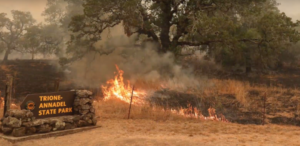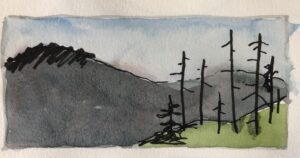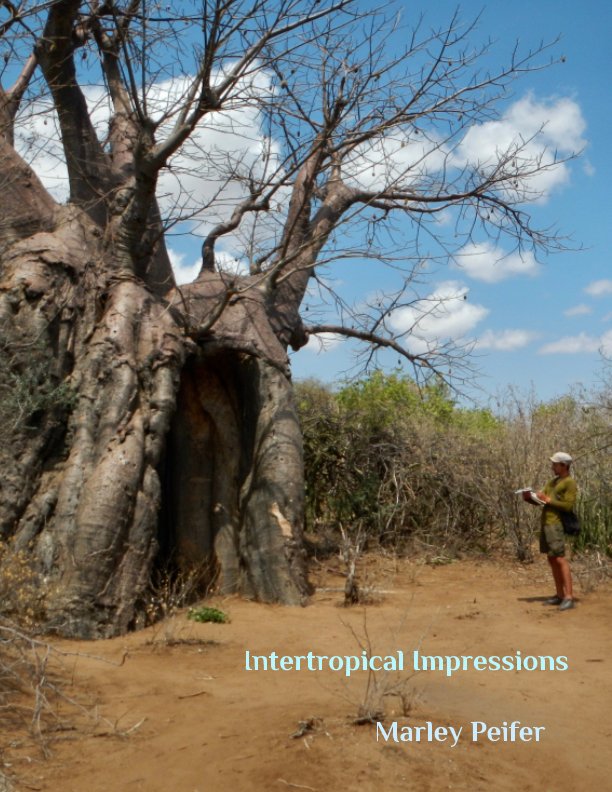Let’s practice nature journaling after a fire in Northern California. We will explore the regrowth in Annadel State Park after the 2020 Glass Fire.
So you might be asking: “How can nature journaling be applied to wildfire?” Actually, the powerful thing about nature jouranling is that it is a perspective or a tool more than a subject matter. This perspective can be applied to lots of things. In effect it improves our ability to observe. As it turns out a nature journal can be a great tool to help us:
- learn about fire ecology
- prepare for wildfires
- help change the narrative around fire
- and even to heal from traumatic experiences with fire
In addition to the above benefits nature journaling can help fire professionals as well as contributing to citizen science about fire. Equally important, nature journaling can help Californians and others create resilient fire adapted communities. To learn more about this increasingly important topic check out this article by Miriam Morrill at the Fire Adapted Network.
I have been able to nature journal live fire in several prescribed burn situations. This has been possible thanks primarily to Miriam Morrill and her program Pyrosketchology. These experiences have led me to use my nature journal to investigate more through a fire ecology lens. I have also been invited to teach nature journaling at Cal TREX prescribed burn training exchange programs for the Plumas County Fire Safe Council in 2021.

The 2020 Glass Fire
The Glass Fire was one of the fires that hit Northern California in the 2020 fire season. First starting in Napa County near Glass Mountain Road it quickly spread into Sonoma County. The fire grew to 11,000 acres in one night. Significantly for me, several areas that I nature journal burned in the fire. Partly for this reason I decided to nature journal there in the following spring. Learn more details about the Glass Fire here.
Nature Journaling After a Fire: Safety Concerns
When nature journaling in an area that has recently seen fire there are a few things to keep in mind. Local agencies will generally close areas until they are deemed safe after a fire. However, you should always be responsible of your own safety regardless of what the signs say. Here are a few tips. Luckily, nature journaling makes you more aware of your surroundings 😉
- First of all, you should beware of holes in the ground. Tree roots are sometimes consumed by fire leaving openings underground.
- The most hazardous thing after a fire is dead trees and their branches. Weak branches can fall at a later time. Pay attention to what is above you especially if it is windy.
- You should prepare yourself for changed trail conditions.
- Lastly, you should pay attention to the weather. Flash floods and debris flows are possible in areas that have lost vegetation then experience intense rain.
These safety concerns should not prevent you from nature journaling after a fire. Nevertheless it is good to be informed. Not everything you should look out for is a hazard. Next, I will show you some things you
nature Journaling after a fire: what to look for
- Fire-Following Flowers. First, lets look at flowers. Some flowers will only come up after a fire. I enjoy looking for these species and recording them in my nature journal. This is a classic thing to do in a post-fire area. Do you want to see a whole video about this?
- Succession Ecology. Second, let’s look at succession. Disturbance and regeneration are important parts of nature. Succession is the study of these regenerative patterns.
- Fire-Tracking. Third let’s hire a detective. Sherlock Holmes would be a great companion on your post-fire nature journaling trip. You can also look for clues, use deductive reasoning, and make hypotheses about how a fire moved through the area. I share some of these techniques in the video.
- Mapping Burn Intensity. You can learn about fire in a more nuanced way by looking at the variation in burn intensity. Fire never burns an area homogeneously despite how it is conceived in popular imagination.
- Fire Phenology. Phenology is the study of seasonal patterns in nature. You can add a phenology wheel to your nature journal.

Nature Journaling Post-Fire Ecosystem Change
I have talked about nature journaling ecosystem change in other videos. For example, I interviewed Robin Carlson several months ago about her nature journaling practice. Robin has nature journaled in the same area for several years. The Stebbins Cold Creek Preserve burned in the 2015 Wragg fire. Robin has documented ecosystem change in the area since the fire. As a result she has learned a lot in addition to contributing to citizen science. You can learn more about her Wildfire to Wildflower project here.
Are you new to nature journaling? If so, then this post has the basics : How to Nature Journal in 10 Steps
Do you need help choosing nature journaling supplies? In that case check out Nature Journaling Supplies: What You Need and What You Do Not
